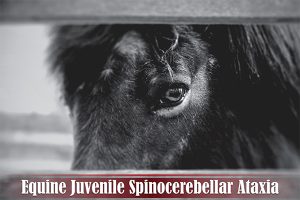Equine Juvenile Spinocerebellar Ataxia
Click here to read the complete article
258 – November/December, 2024
In a world where countless foals are born each year and thousands are registered with the American Quarter Horse Association, the largest equine breed registry in the world, genetic diseases are a significant concern for breeders and owners alike. However, when a disease has affected at least 12 foals in the past four years, it’s understood that this is an inherited condition that can and should be prevented. Addressing this rare disease is crucial to safeguarding future generations of horses.
What is Equine Juvenile Spinocerebellar Ataxia
Equine Juvenile Spinocerebellar Ataxia (EJSCA) is an inherited neurologic disease that causes ataxia in American Quarter Horses. Ataxia is a neurologic condition where the horse is uncoordinated and falls often. It is caused by a genetic variant.
The variant discovered by Carrie Finno, PhD, DVM, Dipl. ACVIM, director of the Center for Equine Health and professor in the Department of Population Health and Reproduction at UCD will be publishing a scientific paper detailing this work and that will provide more details to be released at a later date.
According to the UC Davis Veterinary Genetics Laboratory website, foals affected with the recessive trait developed ataxia, or incoordination, between 1 and 4 weeks of age. In most affected foals, the hind limbs appeared to be more severely affected than the front limbs. As the disease progressed, these foals would turn the hind limbs to one side, with the front limbs planted on the ground, causing them to appear to walk sideways. Within a few days, the affected foals were unable to stand without assistance and had to be euthanized. The published study that first described this disease stated that since 2020, twelve foals have been identified with this disease and all with a fatal outcome. (https://pubmed.ncbi.nlm.nih.gov/38669583/)
Click here to read the complete article
258 – November/December, 2024











